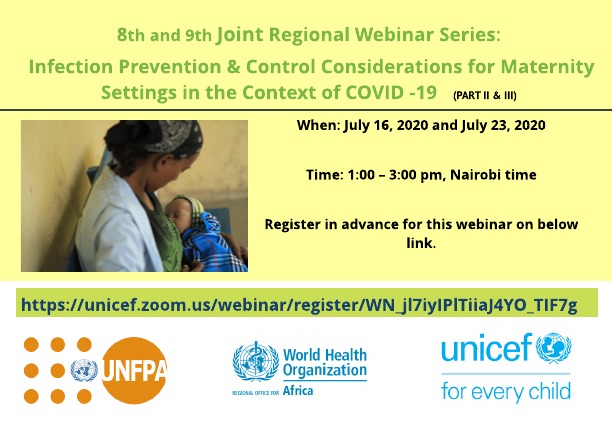As of March 2020, the outbreak of coronavirus disease (COVID-19) was declared a Public Health Emergency of International Concern, and the virus had spread to many countries and territories. While COVID-19 continues to spread, communities must take action to prevent further transmission, reduce the negative impacts of the outbreak and support control measures. Fragile and weak health systems in Sub-Saharan Africa are already overstretched and preliminary estimates and informal conversations with countries indicate adverse implications on the health of mothers and newborns. In as much as COVID-19 is the litmus paper to test the resiliency of the health systems in the region, it also provides an opportunity to enhance health service delivery capacity, and to create and maintain trust in public health systems.
Experiences from Ebola outbreaks have taught us that it had a worse impact on the maternal and newborn health, with most maternal and child health indicators significantly worsening during the epidemic.[1]’[2] In fact, deaths from other preventable causes surpassed the total number of deaths from Ebola. Women’s and children’s vulnerability also increase as protection mechanisms breakdown during crises. Already, there are reports of increased incidence of GBV in the region (South Africa: 87,000 GBV reports in the first week of lockdown; Tunisia: fivefold increase in reported GBV after the lockdown), high levels of adolescent pregnancies, and violence against children. The public health community especially in SSA, must learn from previous outbreaks and ensure that health systems have the capacity to provide equitable access to essential service delivery throughout an emergency (such as COVID-19), limiting direct mortality and avoiding increased indirect mortality (WHO 2020).
In the preparation and response to COVID-19, countries in Sub-Saharan Africa expressed the need to have operational guidance over and above the strategic guidance provided from the global response coordination mechanisms. It was also noted that countries were rapidly developing technical guidance based on publications that had not been graded or included in global systematic review to gauge their validity, effectiveness or safety. At that time, information on COVID-19 in MNH settings was limited due to the few numbers of cases. In response to this, three UN agencies in Eastern and Southern Africa (WHO, UNFPA and UNICEF) jointly adapted the global COVID-19 guiding documents to develop a joint regional technical reference document for the continuity of essential MNH services within the COVID-19 context.
The aim of the document is to have a one-stop shop for guidance addressing the provision of MNH services during the pandemic, thus minimizing the need to refer to multiple guidance documents and then applying the information to maternity settings. The document provides a set of targeted immediate actions that countries should consider at the national, sub-national and health facility levels to reorganize and maintain access to essential quality health services for all mothers and newborns. It also provides easy to follow flow charts on provision of ANC, intrapartum care and postpartum care for the mother and the baby in asymptomatic or non-exposed women and for moderately to severely infected pregnant women. It also has an extensive section on infection and control specifically adapted for maternity settings. It is a living technical document, updated from time to time as new evidence on COVID-19 emerges.
Following the development of the reference guide, the need to strengthen capacity of country teams to apply the guidance in their settings and to continue the provision of MNH services was noted. In this regard, WHO, UNFPA and UNICEF offices are jointly conducting fortnightly webinars with the following objectives:
- To share the up to date information on maternal and newborn health in the context of COVID-19
- To provide a platform for countries for south-south learning
So, far we have conducted seven webinars with over 900 participants from 23 countries, representing diverse organizations and including frontline maternity health care workers.
The webinars are designed to provide practical implementable guidance that can be applied within maternity settings at all levels of health service delivery. In this regard, we have engaged global experts in various areas to provide the most up to date evidence-based information to guide delivery of safe and quality maternity services during the pandemic.
Both the webinar series and the reference manual have informed development of national and regional continuity of services guidance, as well as the development of national guidelines on provision of MNH services in the COVID-19 context. As part of the webinars, participants are given the opportunity to propose areas in which they need more updates or training. These views are taken into consideration while planning subsequent webinars.
[1] Jones SA, Gopalakrishnan S, Ameh CA, et al. ‘Women and babies are dying but not of Ebola’: the effect of the Ebola virus epidemic on the availability, uptake and outcomes of maternal and newborn health services in Sierra Leone. BMJ Global Health 2016;1: e000065. doi:10.1136/ bmjgh-2016-000065
[2] Effect of Ebola virus disease on maternal and child health services in Guinea: a retrospective observational cohort study. DOI: https://doi.org/10.1016/S2214-109X(17)30078-5
